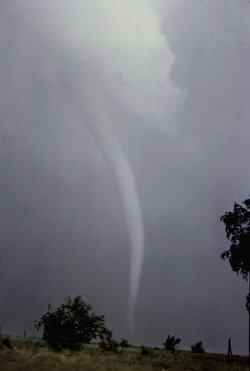Raining animals
|
|
Raining animals is a relatively common meteorologic phenomenon, with occurrences reported from many countries throughout history. The animals most likely to drop from the sky in a rain fall are fish and frogs, with several types of birds coming second. Sometimes the animals survive the fall, notoriously fishes, suggesting a small time gap between the extraction and the actual drop. Several witnesses of raining frogs describe the animals as startled, though healthy, and going on to their businesses shortly after the event. In some incidents, however, the animals are frozen to death or even completely enclosed in blocks of ice. These occurrences may be an evidence for the transport of the victims to high altitude, where the temperature is below zero and show how powerful meteorological forces can be. The potential violence of this phenomenon is shown by examples where the product of the rain is not animals, but shredded pieces of meat.
Scientific explanation
Raining animals were first described by Pliny in the 1st century and ever since caused astonishment and perplexity. Almost every supernatural force was invoked to explain this phenomenon, from God to extraterrestrial entities. Some imaginative theories include teletransportation and psychokynesis, although the motives of the mastermind behind the event remain to be explained.
The scientific explanation of this phenomenon involves a combination of geographic circumstance and meteorological chance. During a storm, wind may sweep the earths surface at great speed. These can develop into whirlwinds or even small tornadoes that can catch debris in the surface. The rain of water-born animals such as amphibians or fishes is explained with the passage of such whirlwinds over lakes or rivers; land animals are abducted directly from the surface and birds can be taken while on flight. Once trapped in the winds, the animals can travel over long distances or taken to the higher parts of the stratosphere, before being dropped in the form of rain somewhere.
Raining animals in culture
Probably the most common reference of this phenomenon in culture is the expression raining cats and dogs that describes copious rains. This sentence appeared first in Jonathan Swifts work A Complete Collection of Polite and Ingenious Conversation, but its origin is unknown. An explanation suggests that the expression is a distortion of the French word catadoupe. Another goes back to the Middle Ages, when sanitary conditions were less strict than nowadays and dead cats and dogs left in the street were flushed away during big rains.
Some groups of Australian aborigines and Native American share the belief that raining frogs is a sign of incoming rain, which is in good accord with the scientific explanation. Frogs (and a scuba-diver) fell from the sky in the end of Paul Thomas Anderson 1999 movie Magnolia.
Occurrences
The following list is a selection of examples, focussing on the United Kingdom and the United States of America.
- Fish
- Cambridge, Maryland, 1828
- Rahway, New Jersey, November 13 1833
- Aberdare 1841
- Mountain Ash, Glamorganshire, Wales, February 9, 1859
- Olneyville, Rhode Island, May 15, 1900
- Tillers Ferry, South Carolina, June 1901 (catfish)
- Marksville, Louisiana, October 23, 1947
- Great Yarmouth, Norfolk, August 8 2000
- Wiltshire, England, May 2001
- Knighton, Powys, August 18 2004
- Frogs and toads
- Trowbridge, June 16 1939
- Leicester, Massachusetts, September 7 1953
- Llanddewi Brefi, Wales, 1996
- Villa Angel Flores, Mexico, June 1997
- Croydon, London, March 1998
- Others
- An unidentified animal fell in California ripped to tiny pieces of meat on August 1 1869; a similar incident was reported in Bath, Kentucky in 1876
- Jellyfish fell from the sky in Bath in 1894
- Assorted dead birds, including ducks, woodpeckers and canaries in Baton Rouge, Louisiana, November 1896
- A turtle enclosed in ice dropped from the sky in Vicksburg, USA in 1930
See also
External references
- Raining cats and dogs (http://www.phrases.org.uk/meanings/298100.html)
- Raining animals in the British Isles (http://www.uk-tourist-information.com/myst/anomalies.html)
- BBC report on raining fish (http://news.bbc.co.uk/2/hi/uk_news/magazine/3582802.stm)
- BBC Bristol (http://www.bbc.co.uk/bristol/content/weather/2003/02/28/raining.shtml)
- BBC Overview (http://www.bbc.co.uk/weather/weatherwise/living/severe/)
- A review on the American perspective (http://www.prairieghosts.com/falls_sky.html)
- Fish rain (http://www.xprojectmagazine.com/archives/strange/fishrain.html)
- Fish rain (http://www.quahog.org/factsfolklore/index.php?id=44)
- Fish rain (http://www.ananova.com/news/story/sm_281822.html?menu=news.scienceanddiscove)el:Βροχή ζώων

